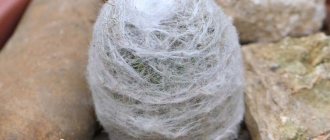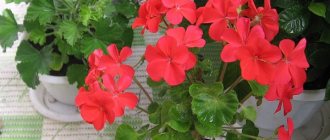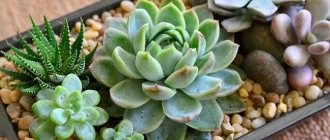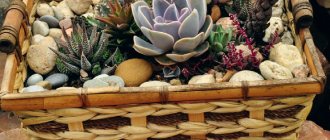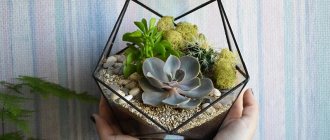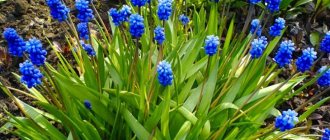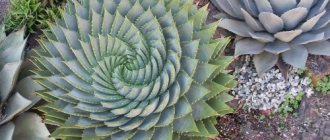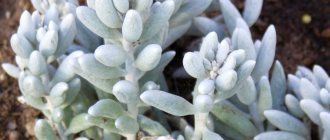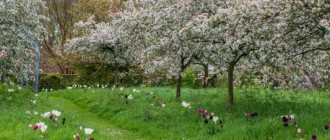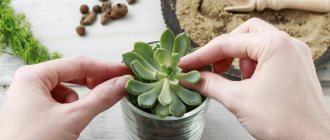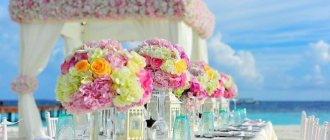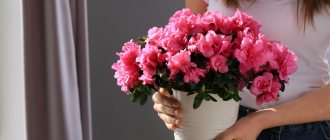Succulents are a real boon for compositions and creativity; they can be planted not only in shells, driftwood, coconut shells, cups, cracks on the walls, but also in anything your imagination suggests. Of course, we wouldn’t want to limit it, so here we will present only what will really be useful and will help you create your own unique composition with your own hands. The article is mostly a selection of photos, but there are also several universal master classes that will allow you to quickly master the main rules for designing compositions from succulents.
Let's start with the assortment
Let us describe groups of suitable plants and some specific “heroes”. Of course, the entire set of cultures cannot be covered in one article:
- Cacti. But not all of them are suitable for compositions.
- Aloe, various forms.
- Lithops (they are rarely used in compositions with other plants, because the agricultural technology of these plants is very peculiar). As a rule, different types of lithops are arranged in one pot, without other plants.
The most popular plants in compositions:
- Sedums.
- Rejuvenated.
- Aeoniums.
- Echeveria.
Sedums are a huge group of plants. In the photo below, on the left, there is a prominent sedum - plants 30-40 cm high, with bright decorative flowers, on the right - blue sedum - its height does not exceed 5-10 cm:
Young - well known under the name “stone rose” also includes a lot of hybrids:
Aeoniums are plants 25-30 cm high. There are many varieties and varieties:
Aeonium Arborium 'Schwarzkopf'
Aeonium Haworthii Variegta
Echeverias are very popular for creating continuous surfaces, especially flowing effects:
There are many varieties of echeveria. They are actively used for wall planters:
Miniature finestraria with cone-shaped leaves are good for tabletop compositions. Their agricultural technology is similar to that of Lithops: complete absence of watering in winter, careful and meager watering in summer, well-lit place.
Fenestraria Rhopalophylla
Finestraria with lithops.
Ampelous succulents
Rowley's ragwort - original ball leaves. Unpretentious.
Morgan's sedum is a fairly powerful plant with long stems densely covered with leaves. Hanging shoots resemble thick sausages.
Of course, the plant is highly decorative and solo, but it is also actively used in compositions. True, in the photo below there is a Burito sedum very similar to it:
Sedum Burrito:
Sedum Burrito
It is also worth looking at other representatives of the Crassulaceae family: cotyledons, pachyphytums, Kalanchoe, sedums, crassulas, graptopetalums . From other families, the following are suitable: euphorbia, peperomia, senecio, some species of agaves, haworthia, gasteria , representatives of the families Mesembryanthemum and Lastovnevye . Euphorbiaceae family may be suitable .
It makes sense to try your hand at arranging individually planted plants first:
Photo for inspiration
If you have reached the end of this article, which cannot be called short, you are definitely interested in a mini-garden in glass. All that remains is to decide how exactly you will arrange it and in what container. Several photos for inspiration are collected in this section. Enjoy! And good luck!
Aquatic plants don't need soil - just water. Dwarf phalaenopsis feels great in the air - increased humidity for the roots is guaranteed, and it doesn’t need anything more Unusual interior decorations from mini-florariums in glass balls A lamp from a florarium solves two problems at once: lighting and illumination of plants
The lid of the jar can be used to install an LED lantern Gift ideas for March 8th - gentle, unusual Driftwood with bindweed in a glass jar - picturesque These are not ferns, but plants similar to them
Interior solutions for flower lovers Unusual compositions
You can create a garden landscape, recreate mountain landscapes
The choice of container is limited only by the transparency of the glass - it should be crystal, without shades
Glasses, goblets - original decorations made of fresh flowers for the table. It is not necessary to buy a rare plant. From what is “at hand” very good compositions are obtained
The containers are the same, the miniatures are different
This florarium is a complete work of art
Sequence of composition creation
Regardless of the size and shape of the composition, there are general rules for their creation:
- The base container is manufactured. It could be anything. If the composition is flat, a wooden box will do. Soil is laid in layers (universal soil half diluted with perlite is suitable), then a layer of moss.
- A metal mesh will be needed on top; it will allow you to hold the soil if the composition is not a floor one, but, for example, a wall one. Volumetric figures are also created from metal mesh. The mesh can be purchased at construction stores. You can secure it using a construction stapler.
- Seedlings are planted in the holes. You should wait several weeks (at least two) until the seedlings are well established and grow into the ground.
- The composition can be placed in the desired position.
- Watering is not necessary because succulents do not like dampness, but periodic spraying or spot watering will be required.
Now you know how to make almost any composition from succulents. Of course, this is a very simplified scheme, because such important things as the thickness of the soil layer, the mixing of the earth mixture, the selection of moss and decor, that is, in fact, everything that creates conditions for plant roots, are selected individually for each composition - one might say , "approximately". However, the aim is formed quite accurately with experience in growing succulents. If you have been seriously studying them for at least a year, feel their needs, know how to grow a healthy plant, where to put it, what to plant it in, how to water it, then there will be no problems with creating your own masterpiece mix.
A little theory: conditions for keeping succulents
In the article “Succulents: Tips for Beginning Flower Gardeners,” we have already mentioned how extensive the list of home succulents is – it is huge! It includes inhabitants of the desert, representatives of the tropics, and inhabitants of the continental steppes. It is clear that it is simply impossible to provide accurate content data suitable for all species. But there are general principles of care for the group of succulent plants.
- Lighting. The more light the better! But remember: not all varieties like direct sunlight.
- Watering. Twice a month - in summer, once - in winter.
- Priming. The mixture for compositions must contain peat, coarse sand, porous minerals (for example, zeolite) and vermiculite - they will increase breathability and make the soil quite light.
- Drainage. The quantity and quality of drainage is of great importance. The speed of plant growth depends on the thickness of the drainage layer. That is, the more drainage, the slower the succulent grows. This remark especially applies to rosette species.
Container selection
We decided not to waste printed signs, but simply show you as many different containers as possible. It is noteworthy that succulents can get by with a small amount of soil, so even the smallest objects can act as a container.
You can implement any image using:
Shells
Or their imitation from gypsum or cement:
The photo shows a cement sink made specifically for the composition.
Treated wood
It is better, of course, to use wooden containers as flowerpots, and plant the plants in a container that is less exposed to moisture.
Stumps and snags
A charming and very skillfully executed composition with shells.
Toys
Old pots and vases
And the more holey, the better:
Everything you can find in the kitchen
Cups, spoons, scoops for bulk products, baking dishes, beautifully decorated old tin cans, cups, out of order teapots, sardine cans, picnic baskets, candy dishes and dessert dishes:
Vintage of old cans, watering cans, plastic bottles, as in some of the photos above, is a separate process, no less interesting than creating compositions from succulents. It is noteworthy that none of the domestic craftswomen has yet mastered such processing of junk. Many of the arrangements pictured above in recycled vintage containers are commercial arrangements intended for sale. However, they are not much different from amateur ones made by hand, except that on the fly you can hone and simplify the details.
Chairs
There is something nostalgic in such compositions, where succulents tightly cover the chair and it’s not even about the style of the piece of furniture itself. The very fact that the furniture is completely overgrown with plants evokes associations with an abandoned garden and the romance of antiquity.
And even wine corks or eggshells
And in general - any items
What equipment might be needed?
You may not need this information, because additional equipment is needed for complex florariums, which are often ordered. But, if you believe in your abilities and are ready to create original florariums with your own hands, you should acquire the following equipment:
- Thermometer, hygrometer. Needed by moisture-loving crops to maintain optimal levels of temperature and humidity;
- Fan. Needed for large tanks to change the temperature when the sensors are turned on. Perhaps you can find an old computer processor cooler so you don't have to spend money on the purchase.
- Backlight. In some regions of the country, natural lighting is not always sufficient. And some plants love light. Fluorescent lamps are ideal;
- Automatic watering. Installation is not necessary, but it will eliminate additional steps to ensure the desired level of humidity.
Images
This is also purely a matter of imagination, so below are some photos for inspiration.
Landscapes with mountains and rocks
Below we will talk more about landscapes, only more complex. Recreating mountains, cliffs, islands lost in the white foam of sea waves is relatively easy to achieve. Use decorative stone chips, marbles, stones, driftwood, cobblestones, and their plaster imitations.
Stream or waterfall
The technique is quite popular - plants or stones imitate spilling water. This technique is often used in open ground flower beds, using ground cover flowers (pansies, ageratum, soapwort, aubrieta, arabis). Succulents will successfully cope with the same task. Blue-gray echeverias are ideal.
However, nothing prevents the spilled “waves” from being of a different shade:
Succulents can be an excellent addition to a stone stream:
Animals
Mosses for florariums
Stabilized mosses are often used for florariums. This is ordinary moss, in which the water is replaced with a special solution, which, as it were, preserves the plant. It is not dry in appearance or to the touch, but all biological processes have stopped.
Moss can be the only plant in a mini-florarium
More common and easily accessible is Sphagnum moss; in florist shops you can buy a variety that is more suitable for the planned planting conditions. In general, “ordinary” moss can be found almost anywhere where there is enough moisture. In any case, near a well, in a storm drain, etc. Just pick up a certain amount, then place it on the soil, stones, etc.
This is sphagnum
You can grow moss specially - on stones and snags. It will take time, of course, but the result is worth it. If there are seeds, use them; if not, pick up any moss along with the soil in which it grows. Next, take kefir (preferably organic) or molasses, or whey (unpasteurized), add a nutrient medium. The simplest option is grated potatoes into porridge. Add moss to this mixture and mix everything in a blender. Using an old brush, apply to the places where the moss should take root. Since mini-gardens require microscopic doses, you can do without a mixer, just mix the composition well.
Ball and other three-dimensional hanging figures
This is a more difficult task. Ready-made succulent balls cost about 50 Euros on Etsy.
A ball is made from wire with a diameter of..., wrapped with the same mesh, but not completely, a little space should be left so that you can work with the inner surface of the ball. to lay out the surface with a very thick layer of moss and coconut fiber, then fill it with soil suitable for succulents, perhaps looser; a small diameter foam ball can be inserted into the center to prevent dampness and not make the composition too heavy. Close the grid. You can start planting plants.
Trees are created using the same principle.
Panels, paintings and other wall compositions
For Valentine's Day:
Inscriptions and signs
The price of such an original pointer is about $30.
Nothing prevents you from posting any inscription using the same principle.
Wreaths on the door
They are not very popular here, although I must admit that a wreath, including one made of succulents, on a door or on a fence, looks attractive.
Panel from Ikea table
A quite popular online master class on making a composition from a table purchased at Ikea. It is worth noting that the idea is indeed successful and looks stylish.
Imitation of landscapes and landscapes
The use of houses, stones imitating rocks, and miniature bridges makes compositions with succulents charming, but you should not take on such a composition without experience - trial options can be so far from the desired image that disappointment cannot be avoided. In addition to a carefully thought-out composition, preferably in advance and on paper, you will need to spend money on high-quality decor, or find natural materials for it, in addition, you should be well acquainted with the selected succulents.
Simpler in terms of planting are houses with overgrown roofs:
Just below, in a picnic basket, is a village landscape made by a Japanese craftswoman for sale. You can see how finely the details are worked out:
Aquariums and gardens in a bank
Succulents and cacti are great for glass arrangements, despite the criticism. Particular attention should be paid to good drainage, because a glass container for succulents will be too humid, and lighting - because even ordinary glass absorbs light.
Caring for a garden in a jar means periodic spraying, and, of course, it is worth making sure that the room where it is located has clean, fresh air without dust.
And one more important point - the vessel should not be closed.
Petr Lapshin, curator of the collection of succulents at the Institute of Fracture of the Russian Academy of Sciences, harshly criticizes florariums and notes that succulents are completely unsuitable for growing in glass vessels. Let us not allow ourselves to agree with him on everything. Closed glass containers are really not suitable for succulents. However, now there are many vessels that are no less spectacular than closed ones, allowing you to provide succulents with suitable conditions for them, namely:
- Mandatory periodic drying of the soil.
- Good lighting.
In addition, it is worth noting that such compositions are designed to provide pleasure, and it does not have to be long-lasting. This composition is a good way of self-expression, an excellent gift or temporary interior decor. In a few months, plants, even succulents and even in conditions suitable for them, grow and the composition loses its appearance - it has fulfilled its functions, the plants can be planted in other containers, and a new composition can be created in the vessel.
You can use decorative sand
This sand is sold, for example, in the Fix Price network, or in stores for florists.
Options with sand are simple, they do not require a complex arrangement of plants, but in general, compositions “behind glass” are quite complex from a compositional point of view.
How to arrange beautiful succulents, how to combine them? There is a class of people who are able to beautifully compose any form without special training; if you are not one of them, then it makes sense to turn to literature. It is impossible to outline the basics of composition within the framework of this article, so we will simply recommend what to read:
- David Hession: everything about flower arranging - inexpensive and accessible. The book is focused specifically on arranging cut flowers and dried flowers, but the general principles of arranging shapes and lines can be mastered.
- From foreign ones exactly on the topic are books by Deborah Lee Baldwin. All about compositions made from succulents. However, they have not been translated into Russian.
How to replace moss (ground cover plants)
Very similar to Nertera moss. It is also called coral moss, but it is simply a miniature herbaceous plant. It is interesting because, under favorable conditions, it is covered with bright orange, no less bright yellow or lilac/dark blue, purple, and white berries.
Coral moss or Nertera. This plant can be a decoration, but it is difficult to get berries to appear in a jar or ball
Selaginella Krausa and Selaginella Jory. These are compact tropical plants with a leaf height of 2-5 cm. They form dense cushions of bright greenery. They can successfully replace moss.
Two more plants that can replace moss in a florarium
Soleirolia. In nature, it forms small mounds about 5 cm high. The foliage is green, in different shades. Long thin shoots with very small leaves. In recent years, varieties with silver and golden foliage have been developed.
Examples of beautiful compositional solutions
Many of them can be created based on the principles of arranging dried flowers and cut flowers. Consider: shape, color, size . Start creating a composition by varying only one parameter (for example, plants of the same shape and color, but different sizes), and then move on to the rest (plants of different shapes, colors, sizes). The photo shows compositions from simple to complex:
Using marbles.
Living colors
For those who have achieved mastery in both growing succulents and cacti and arranging them, enormous opportunities open up for using these plants as paints. The color and shape of the plant are like brush strokes. Also, some of these compositions resemble knitting using the freeform technique.
